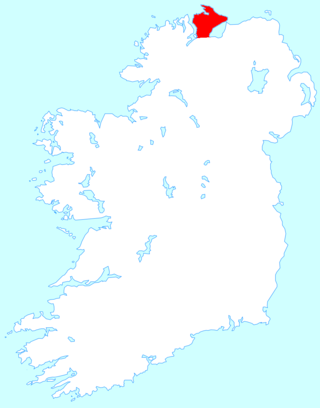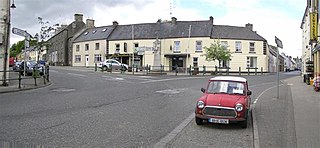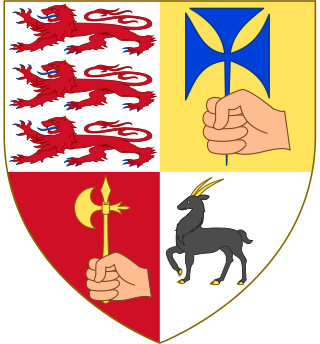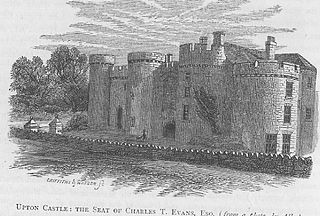Related Research Articles

Dromineer is a small village and townland in County Tipperary, Ireland. It is situated on the shores of Lough Derg on the River Shannon. The village is located 10 km north of Nenagh on the R495 road. It is a civil parish in the historical barony of Ormond Lower. Historic documents describe the places as "Dromynnyre"; the earliest form of the name dating from 1302 was Dromynwyr.

Peel Castle is a castle in Peel on the Isle of Man, originally constructed by Norwegians. The castle stands on St Patrick's Isle which is connected to the town by a causeway. It is now owned by Manx National Heritage and is open to visitors during the summer.

Inishowen is a peninsula in the north of County Donegal in Ireland. Inishowen is the largest peninsula on the island of Ireland.

King John's Castle also known as Limerick Castle is a 13th-century castle located on King's Island in Limerick, Ireland, next to the River Shannon. Although the site dates back to 922 when the Vikings lived on the Island, the castle itself was built on the orders of King John of England in 1200. One of the best preserved Norman castles in Europe, the walls, towers and fortifications remain today and are visitor attractions. The remains of a Viking settlement were uncovered during archaeological excavations at the site in 1900.

Scarriff or Scariff is a large village in east County Clare, Ireland, situated in the midwest of Ireland. The town is on the West end of Lough Derg and is best known for its harbour. The Scarriff Market House is easily recognisable, and it is therefore often used to represent the town.

St Patrick's Purgatory is an ancient pilgrimage site on Station Island in Lough Derg, County Donegal, Ireland. According to legend, the site dates from the fifth century, when Christ showed Saint Patrick a cave, sometimes referred to as a pit or a well, on Station Island that was an entrance to Purgatory. Its importance in medieval times is clear from the fact that it is mentioned in texts from as early as 1185 and shown on maps from all over Europe as early as the fifteenth century. It is the only Irish site designated on Martin Behaim's world map of 1492.

Portumna is a market town in the south-east of County Galway, Ireland, on the border with and linked by a bridge to County Tipperary. The town is located to the west of the point where the River Shannon enters Lough Derg. This historic crossing point over the River Shannon between counties Tipperary and Galway has a long history of bridges and ferry crossings. On the south-western edge of the town lie Portumna Castle and Portumna forest park.


York has, since Roman times, been defended by walls of one form or another. To this day, substantial portions of the walls remain, and York has more miles of intact wall than any other city in England. They are known variously as York City Walls, the Bar Walls and the Roman walls. The walls are generally 13 feet (4m) high and 6 feet (1.8m) wide.

Pettigo, also spelt Pettigoe, is a small village and townland on the border of County Donegal, Republic of Ireland and County Fermanagh, Northern Ireland. It is bisected by the Termon River which is part of the border between the Republic of Ireland and Northern Ireland.
Saint Dabheog is the patron saint and a founder of a monastery on an island in Lough Derg, a lake in County Donegal, Ireland, near the town of Pettigo and shouldering the border of counties Donegal and Fermanagh. His feast day is 16 December.

Quin Abbey, in Quin, County Clare, Ireland, was built between 1402 and 1433 by Sioda Cam MacNamara, for Fathers Purcell and Mooney, friars of the Franciscan order. Although mostly roofless, the structure of the abbey is relatively well preserved. There is an intact cloister, and many other surviving architectural features make the friary of significant historical value.

Loughor Castle is a ruined, medieval fortification located in the town of Loughor, Wales. The castle was built around 1106 by the Anglo-Norman lord Henry de Beaumont, during the Norman invasion of Wales. The site overlooked the River Loughor and controlled a strategic road and ford running across the Gower Peninsula. The castle was designed as an oval ringwork, probably topped by wicker fence defences, and reused the remains of the former Roman fort of Leucarum.
Athlone is a town on the River Shannon near the southern shore of Lough Ree in Ireland. Located on the border between County Westmeath and County Roscommon, the development of the Athlone owes much to the location of a strategic ford on the Shannon.

Inis Cealtra, also known in English as Inishcaltra or Holy Island, is an island off the western shore of Lough Derg in Ireland. Now uninhabited, it was once a monastic settlement. It has an Irish round tower, and the ruins of several small churches, as well as four high crosses and a holy well. Despite the lack of population, the cemetery on this island is still in use. Coffins and mourners are transported the short distance from County Clare in small boats. Boat trips can be taken from the harbour at Mountshannon. It is conserved by the East Clare Heritage Centre.

Ballyhannon Castle is a medieval Irish castle dating back to the 15th century, located near the village of Quin in County Clare, on the west coast of Ireland. It is fully intact and in the Irish Governmental records it is registered as a National Monument and "Listed/Protected" structure, intended to protect its historic, architectural and aesthetic significance.

Garrykennedy is a townland, settlement and harbour in the historical Barony of Owney and Arra, County Tipperary, Ireland. It is located on the eastern shore of Lough Derg, 2 km north of Portroe

The McGrath family is an Irish clan. The name is derived from the Gaelic Mac Craith, recorded in other written texts as Mag Craith, Mag Raith and Macraith, including the Annals of the Four Masters and the Annals of Ulster. McGrath is a surname of ancient Irish origin, and is borne by the descendants of a number of septs, each with a common origin in the Kingdom of Thomond, a kingdom that existed before the Norman invasion and was located in north Munster.

Upton Castle is a 13th-century castle or fortified manor house with an associated chapel, located near Cosheston, Pembrokeshire in Wales. Although in private ownership, the gardens are open to the public. They are listed on the Cadw/ICOMOS Register of Parks and Gardens of Special Historic Interest in Wales.
References
- 1 2 Larkin, Patrick (2012), "The Castles Of Lough Derg: An Illustrated Survey", Journal of the Galway Archaeological and Historical Society, 64: 21–55, JSTOR 24612853
- 1 2 3 "Castlebawn". Archived from the original on 4 March 2016. Retrieved 18 May 2018.
- 1 2 3 4 "Simon's Castle (Simon Flannery)". Archived from the original on 24 June 2016. Retrieved 14 November 2019.
- 1 2 "Castlebawn". Discover Killaloe. Archived from the original on 14 October 2012. Retrieved 21 December 2008.